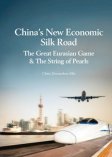The Belt and Road. China’s Most Internationally Divisive Campaign of the Past 25 Years


Having written about China’s Belt and Road ambitions for the duration of its existence, and about China itself for much of the past 25 years, the Belt and Road Initiative has by leaps and bounds become one of the most contentious issues that China has introduced over the past quarter century. Monitoring global news and opinion about the Belt and Road, as we do each week in our “Silk Road Development Weekly“, a collection of BRI articles from around the world, points to how China’s ambitions are viewed. Of the 2,500 articles we’ve highlighted from various media sources, about 50 percent of them are negative, 20 are percent ambiguous, and 30 percent positive in their appraisal. The latter figure decreases if we omit editorials and opinion from Xinhua, the People’s Daily, and other Chinese media outlets.
It is prudent to understand why this should be so, and there are many reasons as to why China’s Belt and Road Initiative attracts such attention. Here are some of my views concerning the critical attention the BRI has garnered.
Jealousy
The BRI is an ambitious plan, taken at face value, in modernizing Eurasia. It is often compared to the American Marshall Plan introduced at the end of WWII. Yet, with the exception of the Soviet Union, neither the United States nor Europe have managed to make much headway in attempts to unify the Eurasian landmass. An element of jealousy does appear to rear its head from time to time; that the Chinese appear capable of achieving something the Western powers have not.
Fear
Another area is the fear that China will swamp BRI markets and beyond with cheap, shoddy goods and put domestic manufacturers out of business. The current spat over US trade is part of this, with certain aspects of the US unwilling to accept that certain industries (such as auto, and soon aviation) have reached a technological peak and until new fuel technologies become available, are now having competitive advantages whittled away. The trade fear of BRI, and bringing Chinese competitiveness closer to home markets, drives a great deal of the West’s capitalistic fat business angst.
Sovereign mistrust
Contemporary China has its own past to deal with. The historic situation concerning Tibet has divided opinion and will continue to divide opinion for decades. The Chinese claim sovereignty, and the situation is indeed complex. But other opinions hold that permitting the Chinese entry creates an environment where the state will never leave. Mongolia, faced with the option of either siding with the Soviet Union or with China in 1924, chose Moscow as the longer term view held that Mongolia would one day see the Soviets leave. That eventually occurred in 1992. A similar situation is now playing out in the South China and East China Seas, while nearly all of China’s neighbors continue to hold border disputes of one kind or another. Russia, too, is concerned about Chinese investment in the Far East, rich in commodities but lacking in manpower. A hungry China with hundreds of millions of people at its disposal, remains both a friend and a potential foe. Allowing China in to build infrastructure, and especially in high-tech, where rumors of hidden “off switches” being included, creates an atmosphere of unease.
Dodgy PR
China has not been especially good at promoting its interests, although it does try and continues to spend a fortune on its image. English language newspapers (I can pick up a complimentary copy of “China Daily” in the lobby of the Union Square Hotel in San Francisco both in print and online) proliferate, there are Confucius Institutes around the globe, Chinese Embassies ditto, and state sponsored ‘fun’ videos promoting even the CPC and even the BRI itself. Yet frankly, a lot of the softer side of Chinese PR is crap. It falls between two stools, either being dry and bland or so pointlessly cheesy it makes no impact. The Communist Party of China lacks the coolness that even the Soviet Union managed to instill among its citizens. It needs a radical overhaul.
It’s only for Chinese businesses
The BRI has been described as a mechanism for China to export its over-capacity, and to export workers that otherwise would be unemployed in China. Its also been described as being a ‘Chinese-only club’ in which Chinese SOEs hoover up all the project fees and profits. This is a short term view and akin to jealousy. In fact, why should the Chinese share out projects they themselves have instigated? Chinese contractors are generally more competitive than others and just as, if not more, qualified in engineering skills. Foreign businesses are participating: Siemens, GE, Bombardier, and many others are actively engaged via their Chinese JV partners. Complaining about Chinese contractors taking new business opportunities away is sour grapes. In fact, a softer and more intelligent response by foreign businesses in participation would see them look at the opportunities being created by the infrastructure build, not the infrastructure building itself.
Debt traps
This is an extension of the mistrust issue but has been bandied around in the press as a given, in that the theory suggests that China entices other countries to borrow money at unsustainable rates, then extracts significant concessions when they are unable to pay. There are a number of issues here, not all of which work in China’s favor. Many of the countries China has been dealing with along the BRI are democracies, whose leaders and governments change from time to time. Some are pro-China, others less so. Some are corrupt, and China has shown willingness to release monies it must know are not bound for national coffers. Yet, the debt trap issue falls short in my view. Yes, China will negotiate loan agreements, but this is normal. Try defaulting with a Western finance house and see what the penalties are. Critics also confuse the issue by forgetting that the infrastructure being financed by China doesn’t belong to China. They also forget the opportunities such infrastructure build brings. While the Chinese may have charged Sri Lanka a lot for the roads and airports, for example, they have also helped develop a tourism industry worth considerably more than the infrastructure cost ever was. Meanwhile, both Malaysia and Pakistan are currently in the process of renegotiating BRI deals. That is rather different than suggestions that China lends and then there is no hope of escape.
Expansionism
To Communist regimes, talk of Empire and Colonialism are dirty words. China is well aware of its history and the behavior of foreign powers towards it in the past. Yet, that is exactly what China is often accused of in its BRI ambitions. With the arguable exception of Tibet, a few smaller border re-negotiations and maritime areas, China has not expanded its territory since the CPC came to power. It is hard to see where China would expand without facing massive disturbances. The Chinese people are not used to seeing its soldiers in foreign lands or coming home in body bags. Talk of Chinese soft influence in terms of resettlement is also rebuffed by both India and Russia, who remain wary of the issue and have the most problematic borders in this argument. Chinese empire building is unlikely.
Soft power and regional control
China is marching ahead with technologies, as is Russia. 5G, for example, has already been launched in Shenzhen and several Russian cities. Yet on a recent trip to Germany, the public access wifi was awful. Frankfurt airport, an international hub, had next to useless public internet access, a situation that continued as I traveled. The country remains almost 2G in its national technology. That technological gap isn’t China’s fault, it is the fault of Western politicians and state monopolies to have brought several EU nations to such a backward state. I dealt with the backward nature of EU technologies in the article “Winners and Losers in the EU’s Digital Connectivity with China and OBOR“, which identified a multitude of EU nations that are well behind both Chinese and Russian investment in connectivity.
China is also accused of soft power abuse toward the EU with its 16+1 initiative, which sees China regularly meeting with eastern members of the EU as well as EU border nations. Often these involve funding of projects. China’s diplomatic reach here shows off its strengths, and Brussels worries it is losing influence. In fact, much of the criticism directed at China is from this area. Very few of the EU members actively support China’s Belt and Road, with Brussels co-coordinating a negative political approach. The reasons are not entirely clear, other than a concern over China’s ‘creeping influence’. Yet, it is unclear within the EU what this fear is really about.
Much mooted talks over commencing discussions concerning an EU-China Free Trade Agreement have been under discussion since 2012. Just to agree to talk. Meanwhile, opportunities of increasing EU trade with China and the BRI, including the prospect of increasing exports to China are pushed to the side. Brussels appears to have no specific plan to deal with the BRI except to try and block it and voice disapproval. Perhaps if progress had been made over what to talk about in terms of free trade, China would not feel the need to exert pressure in other ways. At this juncture, the current impasse is a symbol of EU political weakness overcoming the overriding aims of trade and commerce. It is also unsustainable. China will be trading with the EU whether it likes it or not, and Brussels needs a coherent policy in place to deal with that.
Meanwhile, China has cosied up to the EAEU with an FTA that could later see Chinese good turn up on the EU’s borders, duty free. The control of ports such as Piraeus in Athens has the EU worried that China will start to control trade flows. That plays again on the fear aspect. Rather than engaging to find common ground, the EU has stalled. The situation has recently worsened in terms of Brussels’ own relations with EU members Hungary and Poland. This is not China’s fault.
There are other situations and plenty of examples that come into the picture when discussing why China’s Belt and Road constantly gets a bad rap. The bottom line is that China is energy, water, and resource poor, and with a demanding population, needs to import to satisfy internal demand. That tremendous need is driving the BRI infrastructure build, yet criticism of the BRI nearly always misses the fundamental point: China needs to import. That should be great news for Eurasian exporters. Yet, by and large it is ignored.
The EU, in particular, appears ill prepared, and with an agenda to maintain the existing status quo of business as is known. The problem with this myopic approach and vested interests is that the world is evolving and China is a large driver behind that. Confronted with knowledge of the new and unproven, much of the West appears to reject the BRI based upon little thought-out premises, and a desire to maintain their own business and trade empires for as long as possible. Hence criticism of the new.
We can already sense from the un-seemingly attitude towards Brexit that the West is not always entirely comfortable with addressing new political and trade realities. The rhetoric has turned into a constant chorus of denial and intransigence. Yet, at the same time, it is hindering progress. Germany’s dreadful communications systems are a case in point. They are no longer world class. The sooner economies wake up to what is happening, properly address the concerns they have and get in strategies to deal with them the better. The Belt and Road represents highways along which China’s future trade will flow. As the worlds’ second largest economy and trading power, ignoring it will cause more damage than good. It is time to learn, study, and engage.
About Us
Silk Road Briefing is produced by Dezan Shira & Associates. The firm provides professional services to foreign investors and Governments on matters of Eurasian and Asian trade and investment, maintaining 28 offices throughout the region, including Beijing and Moscow. The practice maintains a China Belt & Road Advisory Desk. Please email silkroad@dezshira.com or visit us at www.dezshira.com
 Related Reading:
Related Reading:
![]() Belt and Road – China Trade up 14.8 Percent, Reaches US$1.1 Trillion in 2017
Belt and Road – China Trade up 14.8 Percent, Reaches US$1.1 Trillion in 2017
Silk Road and OBOR Business Intelligence
Dezan Shira & Associates´ Silk Road and OBOR investment brochure offers an introduction to the region and an overview of the services provided by the firm. It is Dezan Shira´s mission to guide investors through the Silk Road´s complex regulatory environment and assist with all aspects of establishing, maintaining and growing business operations in the region.
China’s New Economic Silk Road
This unique and currently only available study into the proposed Silk Road Economic Belt examines the institutional, financial and infrastructure projects that are currently underway and in the planning stage across the entire region. Covering over 60 countries, this book explores the regional reforms, potential problems, opportunities and longer term impact that the Silk Road will have upon Asia, Africa, the Middle East, Europe and the United States.







